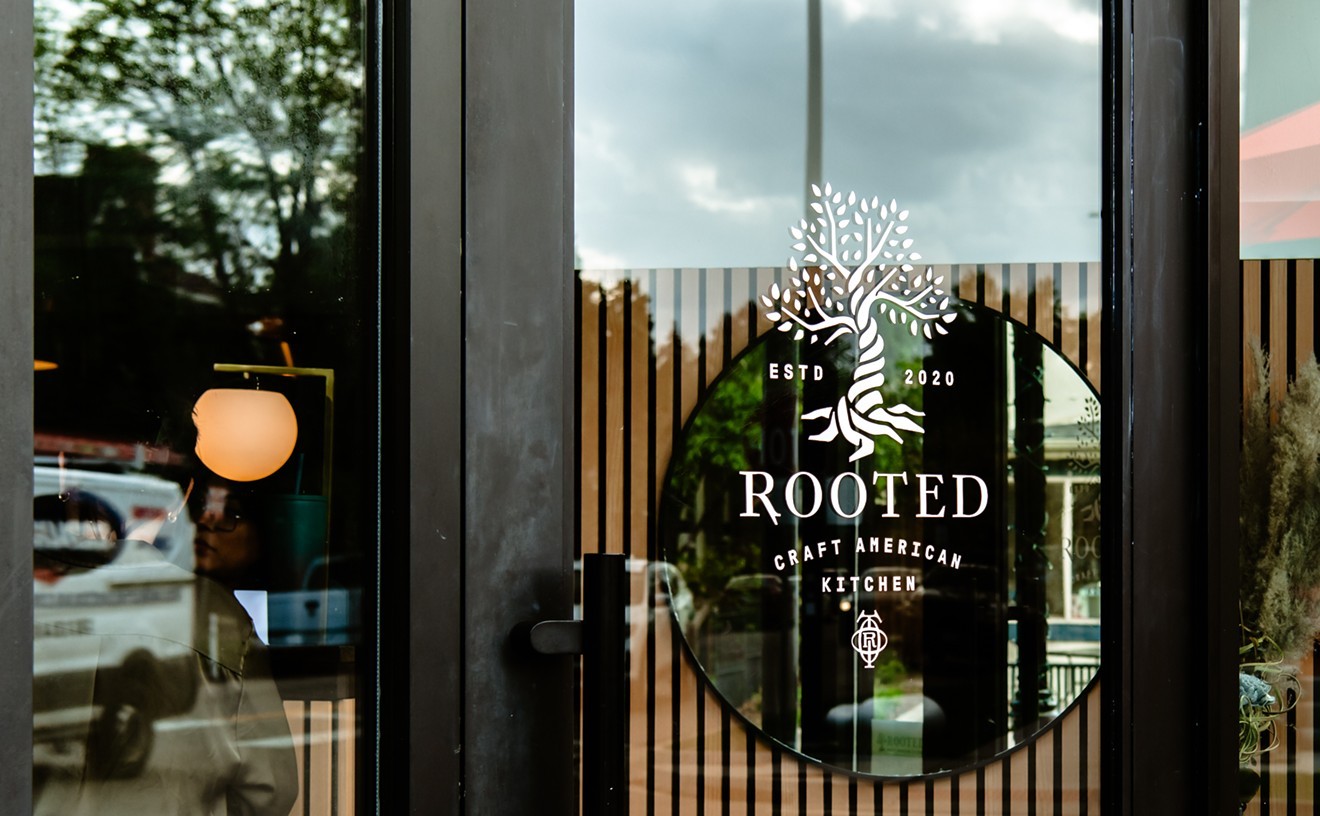Tyson Holzheimer grew up in Montana, in a family where do-it-yourself was a necessity rather than a passing trend. "I first skinned an animal when I was ten," he recalls. Using a knife to separate muscle from skin and bone was just part of his upbringing; by age twelve, he had his hunting license and was shooting elk, deer and antelope with his dad.
"I don't remember my mom ever buying beef," he says. Everything from burgers and sausage to the filling for homemade pot stickers -- the family would join in to make batches of 300 at a time -- came from the game that he and his dad would shoot. At fourteen, he got a job working for a taxidermist, where his knife skills came in handy for the careful skinning required. He learned about anatomy and the musculature of various animals from that job, as customers would bring in all manner of specimens to be mounted. "Someone brought in a coyote they found dead on the road," Holzheimer remembers. "Or rattlesnakes, beaver and mountain lion." That was in addition to more typical game trophies such as elk, moose and bighorn sheep.
See also: Leña Opens a New World of Cooking for Chef Toby Prout
"I didn't realize at the time that I was setting myself up for this," he continues, gesturing to his kitchen at Butcher's Bistro, the new nose-to-tail eatery he started with fellow Snooze alumnus Scott Bauer in the former home of chef Jeff Osaka's Twelve three months ago. But all that work with a variety of four-legged creatures did indeed pave the way for what he's doing now: breaking down whole sides of beef, pork and lamb into usable cuts for dishes both traditional and inventive. "I realized that an elk is the same as a cow and a pig and a sheep," Holzheimer says.His path didn't go directly from processing game in Montana to breaking down primal cuts in an upscale kitchen in Denver, however. Holzheimer knew he wanted to take everything he had gleaned and use it to further his education, so he moved to Anchorage to attend college, thinking the field of biology might be interesting. He started working in kitchens to earn money, washing dishes and doing food prep in the university's food-service facilities before finding his way to a fine-dining restaurant. He soon switched his classroom focus to the school's culinary program, but found he was learning more on the job. In the end, he earned a degree in English literature, but by that time, he'd worked his way through every line position at the restaurant.
Looking for something new, he got a job as a baker, which he held for nearly four years. "I loved that," he says. "Hated the hours, though, especially in the winter." At the time, he relied on a bicycle for transportation and wasn't much of a fan of early mornings and dark days, but at least Anchorage had a thorough system of groomed trails for skiers that he could take advantage of on his bike.
Eventually Montana called him back, and he worked at a number of restaurants in Bozeman and Missoula before getting hired at a private, high-end ski resort near Big Sky. "We had four locations on the mountain," he explains; in addition to the ski lodge kitchens, there were snowcat dinners and other catered events to work. "They were just there to throw money away," he says of the wealthy clientele. But the executive chef was an "old-school guy," someone whom Holzheimer respected -- and the first true chef he had worked for.
"I worked with a lot of guys coming out of culinary school who thought they were chefs," he explains, "but they were really just pompous assholes." His chef and mentor at the ski resort, however, was classically trained and had earned recognition from the James Beard Foundation. "We worked with a lot of high-end ingredients, stuff that was flown in," Holzheimer adds. "That's what the customers wanted."
The main lesson he learned at the resort? "If you make a really good foie gras, you might be a chef," he says. "But if you make a really good foie gras and a really good meatloaf, you're a well-rounded chef."
After six years, Holzheimer and his wife were ready for something new and moved to Denver on a whim. "I wanted to get the hell out of Montana," he remembers. "My wife and I wanted somewhere with more of a food culture."
Keep reading for more about chef Tyson Holzheimer of Butcher's Bistro.
They'd been in town about ten days when Holzheimer interviewed at Snooze. He took the job thinking it would be temporary -- maybe six months at most -- since he'd just be making pancakes. That six months turned into six years as he rose to executive chef and helped open seven Snooze locations, including branches in Arizona and California. "I got to train other chefs, which is cool," he notes. But he also learned the ins and outs of opening new restaurants from the ground up: construction, kitchen layout, hiring, menu planning, provisioning. That was invaluable experience for when he and Bauer decided to open their own place.Opening Butcher's Bistro "was easier than anything we opened with Snooze," he says. Although he and Bauer ran into a few minor problems -- having to paint the kitchen floor twice, for example, because it peeled up the first time -- things went smoothly, for the most part. And they've continued to go well over the past three months. There was a little panic when their meat and dairy provider -- a specialist in locally sourced meats and cheeses -- went out of business in the middle of an incredibly busy holiday week, but they got through.
Much of the menu relies on the timing and preparation of specific cuts; Butcher's Bistro doesn't just receive boxes of pre-cut steaks or chubs of ground beef. Half a cow is brought in as a few primal cuts on Tuesday; whole hogs and lambs come in on Wednesdays. The middle of the week is the most intense for work, as everything is broken down into steaks for sale at the retail butcher counter or on the menu; larger muscles are prepped for slow cooking, cut to be fresh-ground daily for burgers and meatloaf, or cured for further processing. Hams get a thirty-day brine (Holzheimer tried shorter periods but wasn't happy with the outcome), and pork bellies get a four-day cure before being smoked for two hours.
Holzheimer even cuts his own flatiron steaks from the chuck. "It's by far the most time-consuming and complicated to work with," he says. "The flatiron sits along the scapula. Figuring out the bone shape is the thing." He practiced at home in his garage, working with Bauer, before the restaurant opened. "The first time I tried it, I couldn't even see where it [the flatiron] started," he says.
But they got the butchering program in place. "The system we have now is nice; we're just tweaking the details," he says. Most of the small plates are set -- a charcuterie platter and a sausage sampler -- and the big plates evolve as they work through the various cuts. Meatloaf is a regular feature: The kitchen relies on ratios rather than a recipe, and Holzheimer likes the fact that while flavors may change from day to day, the quality is always there.
"All of our beef is so good, we don't need to over-season," he insists. When they get tongue, for instance, braising, peeling and a quick sear on the grill with a little salt and pepper are all the meat needs. He wasn't sure if tongue would sell, so he was bolstered by the response when he put the dish on the menu: "The first people who came in on Saturday at ten ordered grilled tongue and eggs."
Other off-cuts are served in small portions to give guests a taste of something that might be new to them. On the amuse menu, for instance, pig head torchon is only $3 and cured beef heart crostini costs even less. "For two bucks," he notes, "people say, 'If I don't like it, I'm only out two bucks.'"
The new restaurant has kept Holzheimer so busy that he generally just goes straight to bed when he gets home; going out and trying new restaurants has been low on his list. But even on his days off, cooking seems to be at the top. Dae Gee Korean BBQ is one of his favorite spots when he does go out, and he says he always orders the all-you-can-eat option, where he ends up cooking for everyone at the table. "The all-you-can-eat thing is great," he jokes, "because in the end, I'm a fucking glutton."
On a date with his wife to see The Nutcracker one recent Sunday (when Butcher's Bistro is closed), he made dinner for her first at the restaurant. "It would have been more romantic if one of the other chefs could have done the cooking," he says, adding that the dinner date was more trouble than he expected because he'd forgotten that he'd have to fire up all the equipment.
But it sure beats skinning roadkill for a living.
Follow @CafeWestword











